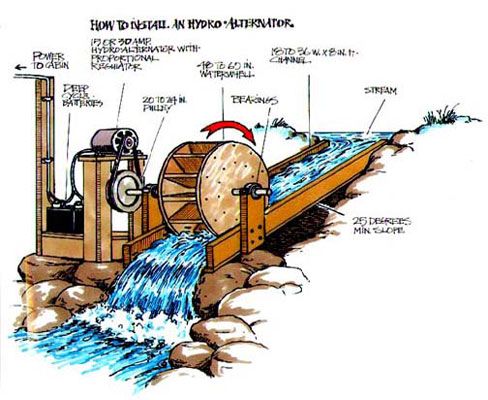
An old buddy of mine in rural Connecticut has, for years, been thinking about ways to power his barn without tapping into his bank account for utility payments. After looking into the overflow coming from a five-acre pond on his property however, he soon realized it wouldn’t provide enough potential energy to spin a turbine. What to do? Well, what he does have is another source of water – a second, much smaller pond – at the top of a hill which leads up through a wooded area on his land. The landscape ascends for a couple of hundred feet, giving rise to the possibility of incorporating “micro hydro” as a possible source of energy.
As a general rule of thumb, micro hydro is a method used to produce hydroelectric power in quantities less than 100 kW – in most cases I’ve read about – a good deal less. What’s so wonderful about this technology is the fact that it can be used to take advantage of low flow water supplies – i.e. my buddy’s small pond set atop that hill. There’s no need for a high flow, long drop waterfall to spin a wheel. With micro hydro, water builds up speed by traveling downhill through a pipe (typically 1 1/2″ – 2″), into a small generator housing. The water then exits the pipe through a nozzle and causes a Pelton wheel to spin. Voilà, electricity.
As with any sort of DIY method, there are MANY ways to go about setting up your own micro hydro system. I’ve put together a few resources on the technology below. Even if you’re not in the market to outfit your home with a system like this, the ingenuity exhibited by so many folks experimenting with this sort of green technology is a sheer joy to behold.
If you don’t fancy yourself the hydroelectric type, perhaps solar energy’s your thing. Have a look at Fine Homebuilding’s recent video segment regarding a solar hot water installation.
Micro Hydro Resources
Micro Hydro in Action
Although it’s not exactly a Pelton wheel, this video of a Turgo turbine will help give you a general idea of how these systems ultimately work.
Overview of Micro Hydro Systems
Some practical considerations regarding flow rate, available power and other topics.
If you’re really serious about trying this yourself, have a look at author Scott Davis’ book, Micro Hydro: Clean Power from Water.
If you’ve experimented with this technology, please let us know in the comments section below. We’d love to hear about the pros and cons of these systems.
Fine Homebuilding Recommended Products
Fine Homebuilding receives a commission for items purchased through links on this site, including Amazon Associates and other affiliate advertising programs.

8067 All-Weather Flashing Tape

Handy Heat Gun

Reliable Crimp Connectors

Design for a simple hydro-alternator.


























View Comments
Not far from the office there is a home set on the bank of a stream. Every single time I drive by it, my mind wanders to two thoughts. One, I've got to be sure to have my 3wt and and a box of small dry flies the next time I pass. There has to be some native brookies holding in those deep pools. Two, the water wheel attached to an outbuilding directly below a water fall has GOT to be hooked up for hydro electric power. I know that it's not (I'm sure that wheel hasn't turned in a hundred years), but man what a resource.